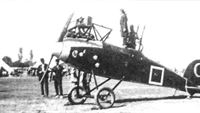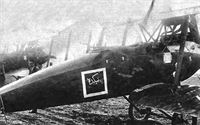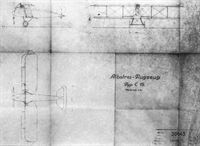
Описание
Страна: Германия
Год: 1918
В.Кондратьев Самолеты первой мировой войны
До окончания военных действий фирма Альбатрос Флюгцойгверк наладила серийный выпуск еще одной двухместной модели - C-XV. Самолет значительно меньших размеров, более простой и дешевый в производстве оснащался менее мощным, но более массовым мотором "Бенц".
C-XV также не мог нести бомб и предназначался главным образом для разведки. Он успел попасть на западный фронт, но никаких оценок боевой работы этого аэроплана не сохранилось.
После войны небольшие количества поздних "Альбатросов" состояли на вооружении различных восточноевропейских стран, включая Польшу и РСФСР.
ДВИГАТЕЛЬ
"Бенц", 200 л.с.
Описание:
- В.Кондратьев Самолеты первой мировой войны
- O.Thetford, P.Gray German Aircraft of the First World War (Putnam)
- J.Herris Albatros Aircraft of WWI. Vol 2: Late Two-Seaters (A Centennial Perspective on Great War Airplanes 25)
Фотографии
-
J.Herris - Albatros Aircraft of WWI. Volume 2: Late Two-Seaters /Centennial Perspective/ (25)
Albatros C.XV 7801/18 at Adlershof Aerodrome late 1918
-
J.Herris - Albatros Aircraft of WWI. Volume 2: Late Two-Seaters /Centennial Perspective/ (25)
Albatros C.XV of the Polish Air Service, circa 1921
-
J.Herris - Albatros Aircraft of WWI. Volume 2: Late Two-Seaters /Centennial Perspective/ (25)
Albatros C.XV of the Turkish Air Service, circa 1922
-
R.Bennett - Last Gathering of Eagles 1918-1920 /Aeronaut/
Albatros C.XV 7818/18, Graf Keller Corps, West Russian Army, Autumn 1919.
-
J.Herris - Albatros Aircraft of WWI. Volume 2: Late Two-Seaters /Centennial Perspective/ (25)
The Albatros C.XIV prototype represented a new direction in Albatros C-type design.
-
J.Herris - Albatros Aircraft of WWI. Volume 2: Late Two-Seaters /Centennial Perspective/ (25)
The Albatros C.XIV prototype shows its compact lines.
-
J.Herris - Albatros Aircraft of WWI. Volume 2: Late Two-Seaters /Centennial Perspective/ (25)
The Albatros C.XIV was the first fourth generation Albatros C-type. It was much smaller and more compact than the mediocre C.X and C.XII that proceeded it. The C.XIV remained a prototype, however a slightly larger but lighter development, the C.XV, was put into production. In appearance the C.XV differed in having horn-balanced ailerons. (Peter M. Bowers Collection/The Museum of Flight)
-
J.Herris - Albatros Aircraft of WWI. Volume 2: Late Two-Seaters /Centennial Perspective/ (25)
This front view of the Albatros C.XIV prototype shows great attention to minimizing frontal area.
-
J.Herris - Albatros Aircraft of WWI. Volume 2: Late Two-Seaters /Centennial Perspective/ (25)
Albatros C.XV 7801/18 at Adlershof (Johannisthal?) was developed from the C.XIV prototype as the last Albatros C-type placed in production.
-
R.Bennett - Last Gathering of Eagles 1918-1920 /Aeronaut/
Albatros C.XV 7815/18, with what appears to be a Russian Orthodox cross beneath the left lower wing. In its long career, it served five masters - Germany, the West Russian Army, Lithuania, Central Lithuania and Poland. (Moshe Bukhman)
-
J.Herris - Albatros Aircraft of WWI. Volume 2: Late Two-Seaters /Centennial Perspective/ (25)
C.XV 7801/18 at the factory. The front view shows the armored radiator that looks like the type applied to the Albatros J.II
-
J.Herris - Albatros Aircraft of WWI. Volume 2: Late Two-Seaters /Centennial Perspective/ (25)
C.XV 7801/18 at the factory. All controls were aerodynamically balanced for improved maneuverability.
-
J.Herris - Albatros Aircraft of WWI. Volume 2: Late Two-Seaters /Centennial Perspective/ (25)
C.XV 7801/18 front view illustrates the clean lines for a biplane.
-
J.Herris - Albatros Aircraft of WWI. Volume 2: Late Two-Seaters /Centennial Perspective/ (25)
C.XV with experimental dual radiators.
-
J.Herris - Albatros Aircraft of WWI. Volume 2: Late Two-Seaters /Centennial Perspective/ (25)
Albatros C.XV C.7838/18 in postwar transport service with civil designation D 186.
-
J.Herris - Albatros Aircraft of WWI. Volume 2: Late Two-Seaters /Centennial Perspective/ (25)
Albatros C.XV C.7838/18 in postwar transport service with civil designation D 186 with pilot and passengers.
-
J.Herris - Albatros Aircraft of WWI. Volume 2: Late Two-Seaters /Centennial Perspective/ (25)
Albatros C.XV C.7838/18 in postwar transport service with civil designation D 186 taking off. (Peter M. Grosz Collection/SDTB)
-
J.Herris - Albatros Aircraft of WWI. Volume 2: Late Two-Seaters /Centennial Perspective/ (25)
The civil Albatros C.XV of Lt. Koopen for his proposed flight to the Netherlands East Indies. "Holland" is painted under the starboard lower wing and "Java" is painted under the port lower wing, (via F. Gerdessen)
-
J.Herris - Albatros Aircraft of WWI. Volume 2: Late Two-Seaters /Centennial Perspective/ (25)
Lt. Koopen's Albatros C.XV with the Netherlands flag painted on the fuselage. Both cockpits have windscreens. The wartime German camouflage fabric still covers the wings and elevator, (via F. Gerdessen)
-
J.Herris - Albatros Aircraft of WWI. Volume 2: Late Two-Seaters /Centennial Perspective/ (25)
Lt. Koopen's Albatros C.XV. It was common practice to move aircraft by train in WWI and this must have been part of the specifications for designers of all sides in the conflict, (via F. Gerdessen)
-
J.Herris - Albatros Aircraft of WWI. Volume 2: Late Two-Seaters /Centennial Perspective/ (25)
Lt Koopen's dismantled Albatros C.XV in the Netherlands being transported to the airfield for erection, (via F. Gerdessen)
-
J.Herris - Albatros Aircraft of WWI. Volume 2: Late Two-Seaters /Centennial Perspective/ (25)
The Albatros C.XV with the Netherlands flag painted on the fuselage. "Duksman Zeist Holland" is lettered in the flag. Preprinted camouflage fabric still covers the wings and elevator, (via F. Gerdessen)
-
J.Herris - Albatros Aircraft of WWI. Volume 2: Late Two-Seaters /Centennial Perspective/ (25)
This photo shows an Albatros C.XV fuselage in Poland; there are no markings yet but camouflage has been applied to the fuselage, indicating this aircraft may be in the process of erection and painting to enter service.
-
J.Herris - Albatros Aircraft of WWI. Volume 2: Late Two-Seaters /Centennial Perspective/ (25)
Limited resolution photo of an Albatros C.XV in postwar Polish military service.
-
J.Herris - Albatros Aircraft of WWI. Volume 2: Late Two-Seaters /Centennial Perspective/ (25)
Albatros C.XV in post-war Polish service. (Peter M. Grosz Collection/SDTB)
-
J.Herris - Albatros Aircraft of WWI. Volume 2: Late Two-Seaters /Centennial Perspective/ (25)
Albatros C.XV aircraft being shipped to Turkey via ship across the Black Sea. Of the 21 aircraft shipped, only two were able to be assembled and flown.
-
J.Herris - Albatros Aircraft of WWI. Volume 2: Late Two-Seaters /Centennial Perspective/ (25)
Turkish C.XV during assembly showing the Turkish markings on fuselage and tail.
-
J.Herris - Albatros Aircraft of WWI. Volume 2: Late Two-Seaters /Centennial Perspective/ (25)
Turkish C.XV after assembly.
-
J.Herris - Albatros Aircraft of WWI. Volume 2: Late Two-Seaters /Centennial Perspective/ (25)
Turkish C.XV after assembly showing the Turkish markings on fuselage and tail.
-
J.Herris - Albatros Aircraft of WWI. Volume 2: Late Two-Seaters /Centennial Perspective/ (25)
Both Turkish C.XVs are shown in this view.
-
J.Herris - Albatros Aircraft of WWI. Volume 2: Late Two-Seaters /Centennial Perspective/ (25)
This view shows the markings detail on the fuselage of a Turkish C.XV. The national markings would have been the red square adopted after the war.
-
J.Herris - Albatros Aircraft of WWI. Volume 2: Late Two-Seaters /Centennial Perspective/ (25)
Turkish C.XV with staff.
-
J.Herris - Albatros Aircraft of WWI. Volume 2: Late Two-Seaters /Centennial Perspective/ (25)
Colorfully-marked Albatros C.XV number 8 in Lithuanian service gets inspected by the brass. (Peter M. Grosz Collection/SDTB)
-
J.Herris - Albatros Aircraft of WWI. Volume 2: Late Two-Seaters /Centennial Perspective/ (25)
C.XV recognition chart.








































